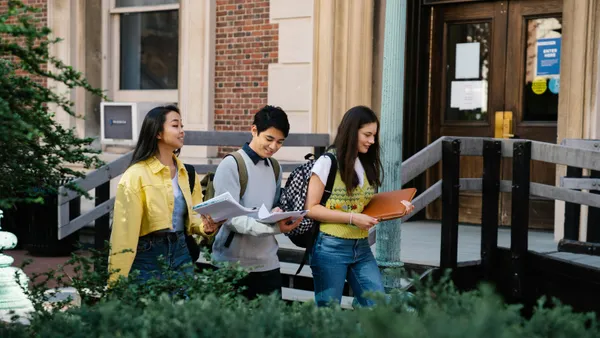Dive Brief:
- Student persistence and retention rates rose for the fall 2020 cohort of first-time students but have yet to recover to pre-pandemic levels, according to a new report from the National Student Clearinghouse Research Center.
- Of the 2.3 million first-time college students in fall 2020, 75% returned to higher education by fall 2021. A majority, 66.4%, stayed or earned a credential at the same college, while 8.6% returned to class at a different institution.
- That persistence rate represents a 1.1 percentage point increase from the previous year’s rate of 73.9%. This year’s gain, to 75%, is a stronger improvement than the historical average but still not enough to reach the pre-pandemic level of 75.9%.
Dive Insight:
The uptick in persistence and retention rates comes as fewer students are enrolling in college, according to Mikyung Ryu, director of research publications at the research center. Enrollment declines have battered the higher education sector in recent years, a trend exacerbated by the pandemic.
"The logical question would be, who's still making it to college?" Ryu said. "In fall 2020, we were deep in the midst of pandemic-related disruptions. The first-time students who still enrolled that semester likely had the resources, ability and willingness to go on to college no matter what was happening."
In fall 2020, the number of first-time students declined by 9.9% compared to the year before, representing about 255,000 students. Community colleges saw the largest decline, of about 146,700 fewer students, according to the report.
Despite those declines, community colleges, along with for-profit four-year institutions, saw significant increases in persistence rates.
Of students starting at community colleges in fall 2020, some 61.5% persisted at any U.S. institution, compared to 58.5% of the previous year’s cohort. At for-profit four-year institutions, 47.4% of the fall 2020 cohort persisted the following fall, up from 44.8% the previous year. Persistence rates at other institution types fell slightly.
The progress in student persistence is primarily due to first-time students transferring to different colleges, according to the report. The transfer-out rate for first-time students bounced back to 8.6% for the fall 2020 cohort. The previous year, it had fallen to 7.7% — driving declines in overall first-year persistence.
Despite the improvements, higher ed has struggled to get persistence and retention rates back to their pre-pandemic levels. For the fall 2020 cohort, the overall retention rate of 66.4% grew by only 0.2 percentage points, up from 66.2%. And the transfer-out rate has yet to reach its historical average of 9.2%.
"It's gonna take a while before we're completely out of the woods," Ryu said.
The research center found gains varied by racial and ethnic groups. The persistence rate for Latinx students, of 69.2%, rose by 0.7 percentage points, recovering slightly from a decline of 2.6 percentage points the year before.
Prior to the pandemic, Latinx students were among the fastest-growing demographic groups in higher education, according to CNBC. However, COVID-19 hit the marginalized communities disproportionately hard and Latinx enrollment stalled as a result.
The persistence rate fell among Native American students. At 60.1%, the rate dropped 2.8 percentage points from last year. They were the only group that saw a decline this year.
Ryu's seen college recruitment strategists take two main approaches when addressing persistence and retention rates — improving student outreach to those already on campus and better identifying former students who may be interested in returning.
"The population with some college but no credential holds a lot of promise for colleges," she said. "This group could help institutions that are struggling fill their empty seats during the pandemic."














